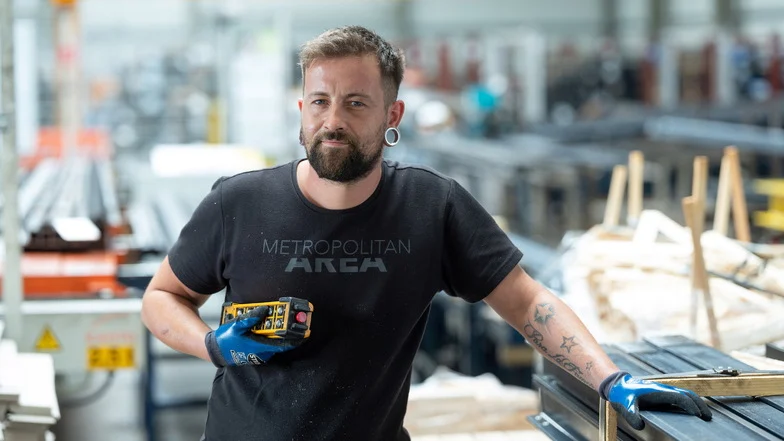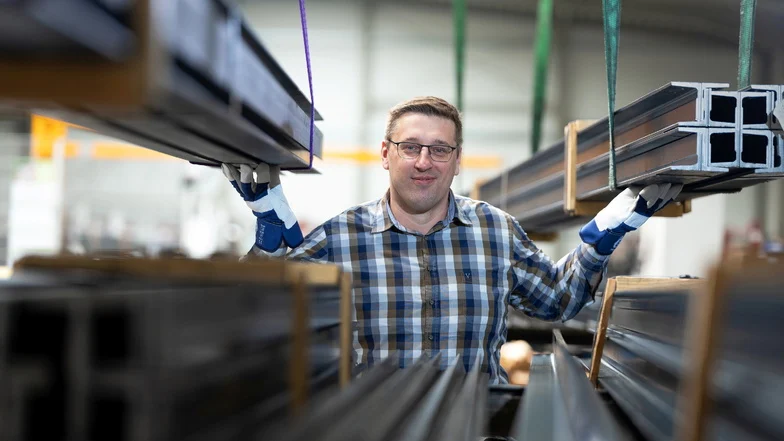From Luisa Zenker
Hoyerswerda. A steel rail hovers in the air. Then employee Erik Theinert slowly lowers the 120-kilo part to pack it up in the workshop and send it out into the world. "You need a lot of strength for this work," says the production helper in a black T-shirt, who actually once learned to be a cook.
But the working hours were too family-unfriendly for him: "Always working in the evening and on weekends, that didn't fit anymore," he recalls. Now he produces for the Hoyerswerda-based company Saverawhose hobbyhorse is manufacturing steel rails for elevators.
Every day, Erik Theinert's shift starts at 6 a.m.. And ends at 1:42 p.m. He grins at the number. "Yes, really," his colleagues also add. And indeed, the 36-hour week has been in effect at the company since June 2021. Since then, the nine employees have been working in the production hall for seven hours and 12 minutes every day from Monday to Friday. "I can pick up my child afterwards," says a delighted Erik Theinert, who receives the same pay as before.

Plant manager Rico Rudolph can answer this question as to why this is possible despite fewer hours.
The 43-year-old became involved with the issue of working hours at an early stage. Before he became an authorized signatory in the company, he worked for other East German corporations. "In one company, our West German colleagues had five more vacation days and were paid according to the collective wage agreement. I wasn't doing badly, but I thought that was unfair. And in the other company, you could get three extra vacation days if you weren't sick. I didn't understand that, why are you punished if you're sick yourself?"
In 2016, Rico Rudolph became plant manager at the Hoyerswerda-based company. The topic of working hours did not let him go. Then came the decision: In June 2021, he reduced working hours for his employees by four hours. The change was also accompanied by scientific research. The professorship for occupational psychology at the Dresden University of Technology compared the Hoyerswerda plant with a partner plant in Hanau, which continued to work 40 hours.
Employees are more satisfied
After just a few weeks, it was noticeable: Rudolph's employees are happier. "At first, they stressed themselves out more because they thought they had to do the same workload in fewer hours." The plant manager took the pressure off them.
After a year and a half, he can say, "My people are less stressed and less sick." Before, each employee recorded 18 sick days a year; now it's only 11 days.
And that's where Rudolph's secret recipe lies: By making his employees less sick, productivity is at a similar level as before, he says. "The shortened working hours make people happier, more relaxed, less stressed, and that can never be counterproductive for companies," says Rudolph, who criticizes employers who demand a lot but are uncreative about changing conditions.
His work model also makes him more attractive to employees. A plus point in view of the shortage of skilled workers. He also refers to pilot projects in the United Kingdom. They also show that employees are more productive with shorter working hours: Employees with shorter working hours are more productive, less stressed and less likely to be ill.
The boss himself remains at 40 hours
"Times have changed," Rudolph says. "There has to be something other than just going to work." He dismisses the notion that young people have become lazier. "They're more aware of life and much more into digital." He also comes to talk about the post-war generation that built Germany through hard work. "But nowadays there are no more typewriters or index cards where everything has to be entered by hand. Why shouldn't my people benefit from digitization?"
- The overview of all news from Saxony's economy is available once a week with our newsletter "Economy in Saxony" -. register here for free.
With his model, the white-shirted plant manager is at odds with the Prime Minister of Saxony. The latter recently called for every employed person in Germany to work one hour longer per week in order to eliminate the shortage of skilled workers.
The plant manager himself continues to work 40 hours a week. He can only offer this to his employees because he is an authorized signatory working for the Spanish parent company Savera.
His managing director initially found the work model risky, but was quickly impressed by the TU Dresden study. The plant manager seems to be willing to take risks in general, because: Even now, he wants to stick to the weekly hours despite the weak economic situation. The plant in Hoyerswerda was on the verge of closure last year, with half of the workforce being laid off. This was because the company was owned by the Russian company Voul Stahltechnik. Because of the Russian war of aggression on Ukraine, Rudolph's customers no longer wanted to buy goods from Hoyerswerda.
In addition, the Russian company withdrew from Germany due to the sanctions. Fortunately, says Rudolph, the Spaniards arrived at the same moment. They took over Hoyerswerda. But they are not entirely spared by the economic situation. While they used to produce 20,000 elevators a year, they now produce 15,000, he says, which also has to do with the slump in the construction industry. "If no houses are being built, there is no need for elevators," says the plant manager. However, he says, a major customer has already come knocking on the door again, because the German government's target remains: 400,000 new homes a year, whether at 32, 36 or 40 hours.








